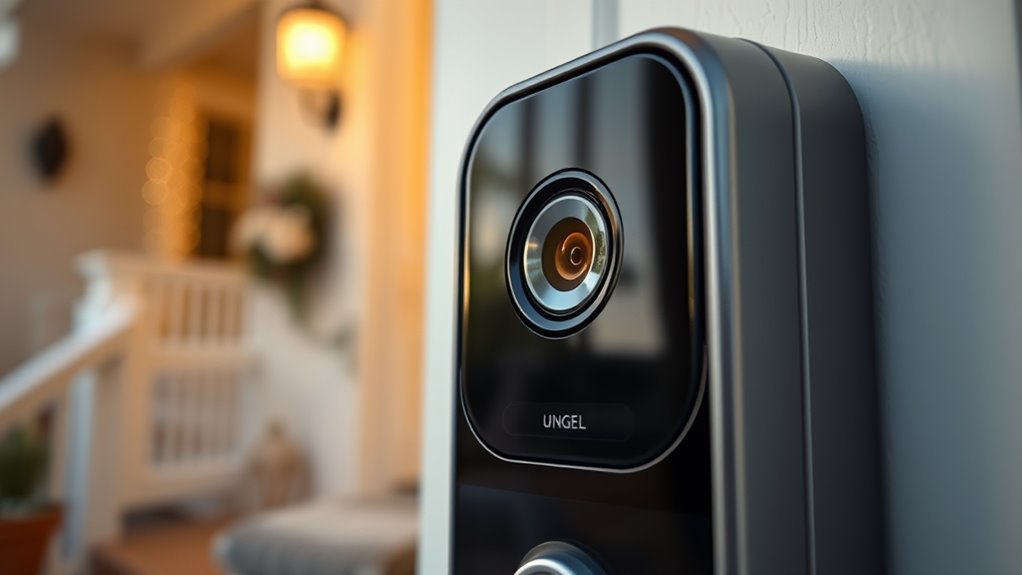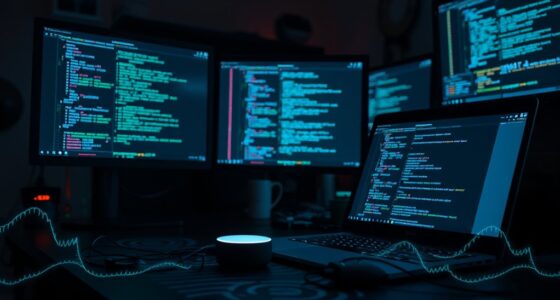To protect your doorbell video feeds from AI-driven deepfakes, stay alert for signs of tampering like unnatural facial movements, inconsistent lighting, or blurry backgrounds. Use devices with AI-driven verification features and keep firmware updated regularly. Incorporate multi-factor security systems and verify suspicious footage with multiple trusted sources. By staying vigilant and adopting advanced security practices, you’ll reduce the risk of being deceived by deepfake manipulations. If you continue exploring, you’ll discover more effective ways to safeguard your smart home.
Key Takeaways
- Implement multi-factor verification, combining facial recognition with behavioral analysis to detect anomalies in video feeds.
- Regularly update doorbell firmware and security software to patch vulnerabilities exploited by deepfake manipulation.
- Use AI-based deepfake detection tools that analyze facial inconsistencies, lighting anomalies, and unnatural movements.
- Cross-verify video footage with trusted sources or alternative surveillance systems before acting on suspicious content.
- Educate users on deepfake indicators and promote cautious skepticism of unexpected or emotionally exaggerated footage.
Understanding Deepfake Technology and Its Capabilities

Deepfake technology has rapidly advanced, making it possible to create highly realistic synthetic images and videos that can convincingly mimic real people. At the core of this progress are neural networks, which learn patterns from vast amounts of data to generate lifelike visuals. These networks enable sophisticated data synthesis, allowing creators to produce convincing fake footage with minimal effort. By training neural networks on existing videos and images, deepfakes can generate new content that appears authentic. This capability means you might encounter highly convincing videos that are entirely fabricated, posing significant challenges for verification. Understanding how neural networks and data synthesis work together helps you grasp the potential and risks of deepfake technology in today’s digital landscape.
How Deepfakes Are Used to Manipulate Doorbell Footage
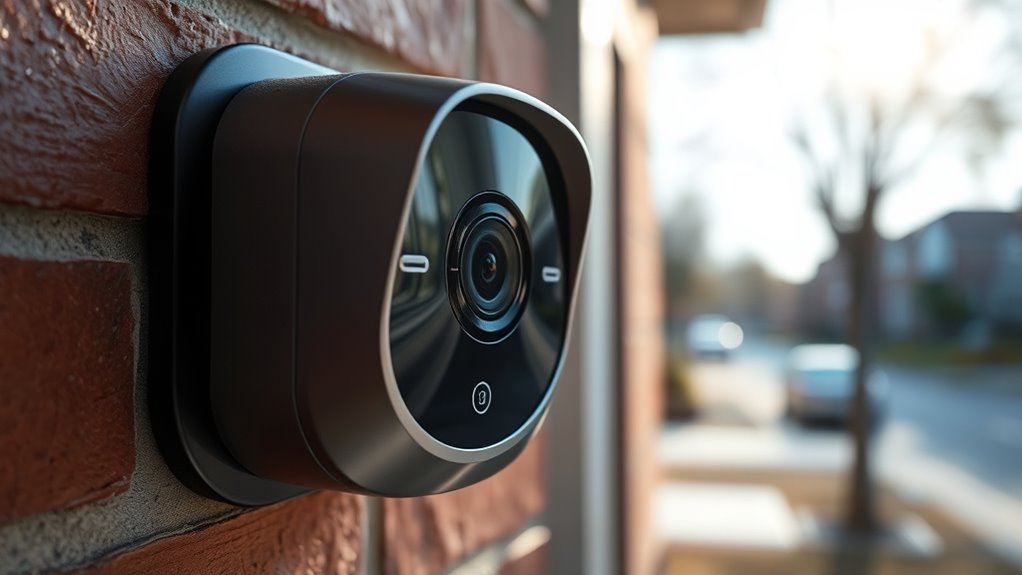
Deepfakes can create fake identities or alter visitor appearances, making it hard to trust what your doorbell footage shows. They can also hide intrusions by replacing or deleting suspicious activity. Understanding these tactics helps you recognize how your footage might be manipulated. Additionally, awareness of voiceover techniques used in digital content can help distinguish authentic footage from manipulated media.
Fake Identity Creation
How exactly are malicious actors using technology to manipulate doorbell footage? They create fake identities by generating convincing deepfakes of trusted individuals or delivery personnel. This manipulation targets the vital step of identity verification, making it easier to deceive security systems and homeowners. By mimicking familiar faces, attackers can carry out social engineering tactics, convincing residents to unlock doors or reveal sensitive information. These deepfake identities can be embedded into video feeds, making it appear as if a trusted person is present. This deception exploits the trust placed in visual confirmation, allowing intruders to bypass security measures. As a result, fake identity creation becomes a powerful tool for breaching privacy and security, emphasizing the need for advanced detection systems to identify and counteract these AI-driven manipulations. Incorporating Remote Hackathons can foster innovation in developing such detection technologies.
Altering Visitor Appearances
Malicious actors can manipulate doorbell footage by altering the appearance of visitors through advanced deepfake technology. They use facial morphing to create convincing visitor disguises, making it difficult to identify individuals accurately. By changing facial features, they can impersonate someone else or hide their true identity entirely. This manipulation can deceive surveillance systems, allowing intruders to bypass security measures or present false identities. Deepfake technology makes it possible to seamlessly blend different facial features, creating realistic but fake appearances. As a result, you might see a visitor’s face transformed into someone familiar or entirely different, undermining trust in your security footage. The ability to alter visitor appearances highlights how deepfakes threaten the integrity of doorbell video feeds, emphasizing the need for advanced detection tools. Additionally, understanding emotional distance and manipulative behaviors can help identify when someone may be attempting to deceive or exploit trust through such technology.
Concealing Intrusions
By manipulating doorbell footage with deepfake technology, intruders can seamlessly hide their presence and avoid detection. They can replace or distort their image, making it appear as if no one is there or that a different person is at the door. This raises serious privacy concerns, as it undermines trust in security systems. The potential legal implications are significant, especially if these manipulated videos are used to commit fraud or break into homes. Consider the following tactics:
| Technique | Purpose | Impact |
|---|---|---|
| Face Replacement | Conceal intruder’s identity | Avoids identification |
| Background Editing | Remove or alter intruder’s presence | Erases evidence of intrusion |
| Timing Manipulation | Delay or accelerate footage playback | Confuses detection efforts |
These manipulations threaten security and challenge existing legal frameworks. Additionally, the emergence of advanced technology emphasizes the need for robust verification methods to maintain trust in video evidence.
Recognizing the Signs of AI-Generated Video Tampering

When inspecting doorbell footage, look for unusual facial movements that seem out of place or overly smooth. Pay attention to inconsistent lighting cues that don’t match the environment, and blurry backgrounds that can indicate tampering. Recognizing these signs helps you spot AI-generated videos before they cause real harm. Additionally, bedroom elements such as lighting and decor inconsistencies can sometimes reveal digital alterations or tampering with the footage.
Unusual Facial Movements
Unusual facial movements are often a telltale sign that a video may have been manipulated using AI technology. You might notice odd or inconsistent facial feature movements that don’t align naturally with speech or context. For example, expression changes may seem exaggerated, delayed, or abrupt, highlighting a mismatch in how emotions are displayed. These unnatural movements can include blinking irregularities, lip sync issues, or facial tics that don’t fit the person’s typical behavior. Additionally, Vetted – Halloween Product Reviews reveal how artificial enhancements can sometimes be detected through subtle inconsistencies in facial feature dynamics. By paying close attention to these subtle cues, you can better identify potential deepfakes. Recognizing these signs helps you stay alert to manipulated videos, making it harder for AI-generated content to deceive you. Always scrutinize facial feature dynamics for signs of tampering.
Inconsistent Lighting Cues
Inconsistent lighting cues often reveal deepfake videos because AI-generated content struggles to replicate natural lighting conditions. When analyzing a video, look for irregularities in lighting consistency or mismatched visual illumination. For example, shadows may fall in different directions or be absent where they should be, indicating manipulation. Bright spots or reflections might suddenly change or appear inconsistent with the scene’s overall lighting. These anomalies occur because AI struggles to accurately mimic the nuanced interplay of light and shadow in real environments. Recognizing these subtle cues helps you identify deepfakes, as genuine footage maintains consistent lighting throughout. Paying close attention to how light interacts with faces and objects can be a powerful way to spot AI tampering in video feeds. Additionally, dog breed features such as specific physical traits and behaviors can sometimes be used to verify the authenticity of footage involving animals, helping to detect manipulated or synthetic content.
Blurred Backgrounds
Blurred backgrounds are a common sign of AI-generated video tampering because deepfake technology often struggles to replicate the natural sharpness and depth of field seen in real footage. If you notice backgrounds that appear unnaturally blurry or lack the gradual focus shift typical in aesthetic photography, it could indicate manipulation. Genuine videos usually have consistent focus, where the foreground and background blend seamlessly, creating a realistic depth. Deepfakes tend to produce backgrounds that are either overly blurred or oddly sharp, disrupting the visual flow. Recognizing these inconsistencies helps you identify potential tampering. Pay close attention to the background’s clarity in video feeds, especially when the subject remains sharp while the surroundings don’t match natural focus patterns. Understanding visual authenticity can further enhance your ability to detect manipulated videos.
The Risks and Implications of Fake Video Feeds

Because fake video feeds can be convincingly manipulated, they pose a serious threat to security and trust. You could be deceived into believing false information, leading to compromised safety or privacy breaches. The risks include:
- Undermining your privacy concerns by exposing sensitive data
- Allowing malicious actors to impersonate trusted individuals
- Causing wrongful accusations or legal implications
- Eroding public trust in surveillance systems
- Facilitating criminal activities like scams or blackmail
These threats highlight the importance of recognizing the potential for deception. Fake feeds challenge the integrity of video evidence, complicating legal proceedings and personal security. Staying vigilant is crucial to prevent manipulation and protect your privacy and legal rights. Additionally, implementing advanced dog name detection techniques can help identify deepfake content more effectively.
Current Security Measures and Their Limitations
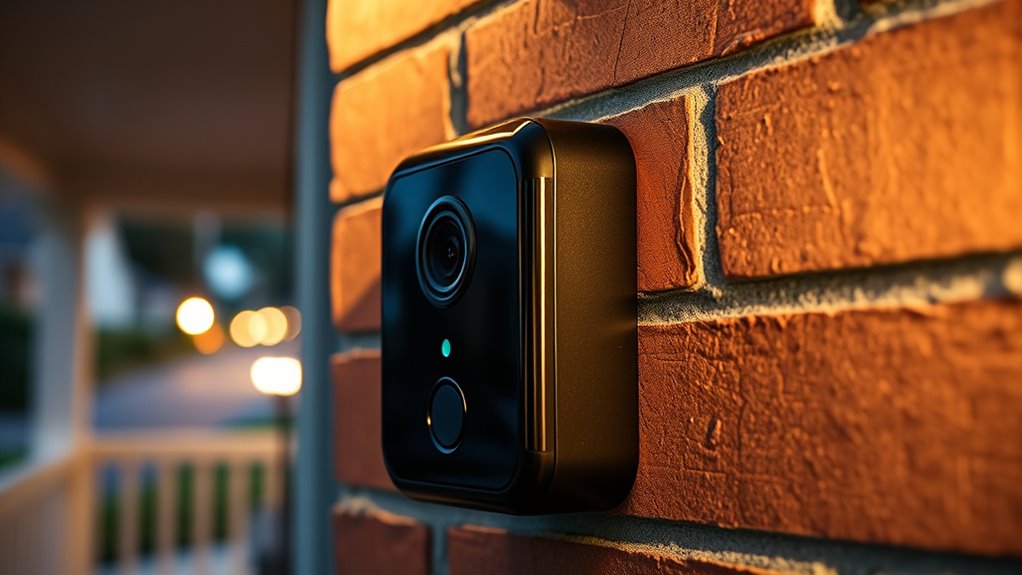
You rely on traditional video authentication and biometric recognition to keep your home secure, but these methods have clear gaps. Fake videos can bypass basic checks, and biometric systems often struggle with accuracy and spoofing. AI tools are emerging to detect deepfakes, yet they aren’t foolproof and can be outsmarted.
Traditional Video Authentication
Traditional video authentication methods rely heavily on security cameras and manual verification to confirm identities or capture footage. While useful, these methods have notable limitations. They often depend on:
- Clear visibility, which can be obstructed or compromised
- Static footage, making real-time detection difficult
- Basic physical security measures that are vulnerable to tampering
- Limited use of voice authentication for identity verification
- Challenges in detecting sophisticated AI-generated deepfakes
These approaches may fail when faced with advanced manipulation techniques, reducing their reliability. As a result, relying solely on traditional video authentication leaves gaps in security. Combining these methods with other measures, like biometric recognition, is necessary but still not foolproof against AI-driven threats. For now, these methods provide a foundational layer but need upgrades for stronger protection.
Biometric Recognition Challenges
Biometric recognition systems are increasingly deployed to enhance security, but they face significant challenges in reliably verifying identities. Voice biometrics can be fooled by recordings or synthetic voices, making it difficult to distinguish genuine speakers from deepfakes. Similarly, facial encryption relies on algorithms that may struggle with sophisticated manipulation or spoofing techniques. These methods can be bypassed if attackers use high-quality deepfake videos or altered biometric data, undermining trust in automated verification. Additionally, environmental factors like poor lighting or background noise can impair the accuracy of facial encryption and voice biometrics. As AI techniques evolve, so do the risks of deception, highlighting the need for more robust, multi-layered security measures to counteract these biometric recognition limitations.
AI-Generated Fake Detection
Detecting AI-generated deepfakes has become a critical line of defense as synthetic media grow more sophisticated. Current AI-fake detection methods use algorithms to identify inconsistencies, such as unnatural blinking or irregular facial movements. However, these measures face limitations, especially concerning privacy concerns and legal implications. You may worry about false positives or unintended data exposure when deploying detection tools. To stay ahead, consider these challenges:
- Evolving deepfake tech can bypass detection algorithms
- Privacy issues from analyzing personal video feeds
- Legal ambiguities around deepfake evidence
- High false-positive rates impacting trust
- Need for continuous updates to detection systems
While these tools help, they aren’t foolproof, emphasizing the importance of balancing security with privacy rights and legal frameworks.
Advanced Techniques for Detecting Deepfake Content
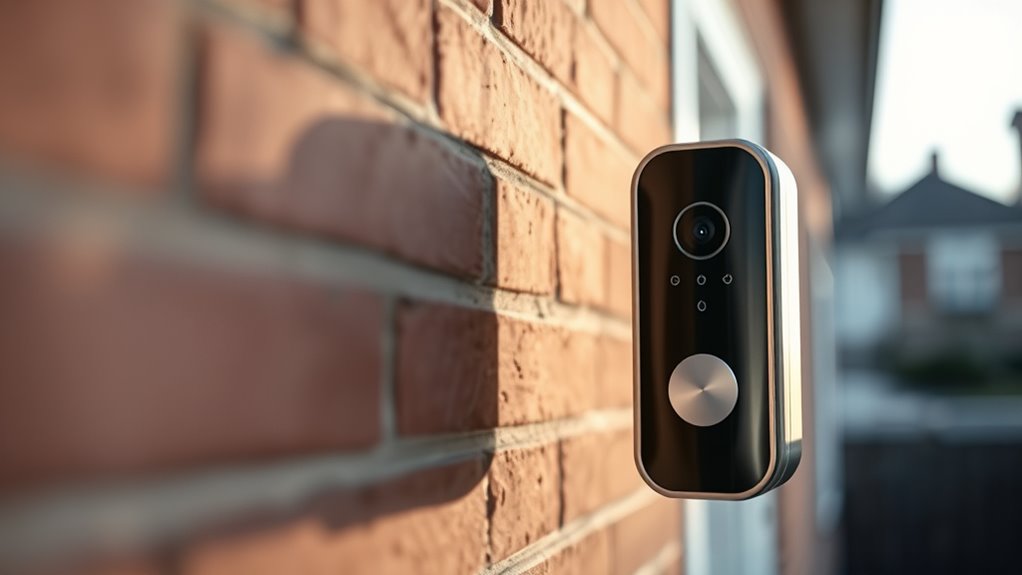
As deepfake technology becomes more sophisticated, researchers have developed advanced techniques to identify manipulated content with greater accuracy. One approach involves analyzing voice recognition patterns to detect inconsistencies or anomalies in speech that are difficult for AI to replicate perfectly. By examining subtle vocal cues, your system can flag potential deepfakes. Additionally, implementing data encryption guarantees that video feeds are secure from tampering during transmission and storage. Encrypted data makes it harder for malicious actors to insert or alter footage without detection. Combining these methods enhances your ability to spot deepfakes early, reducing false positives and increasing overall reliability. These advanced techniques form a vital part of your defense, helping maintain the integrity of your smart doorbell’s video feeds.
Best Practices for Securing Your Smart Doorbell System
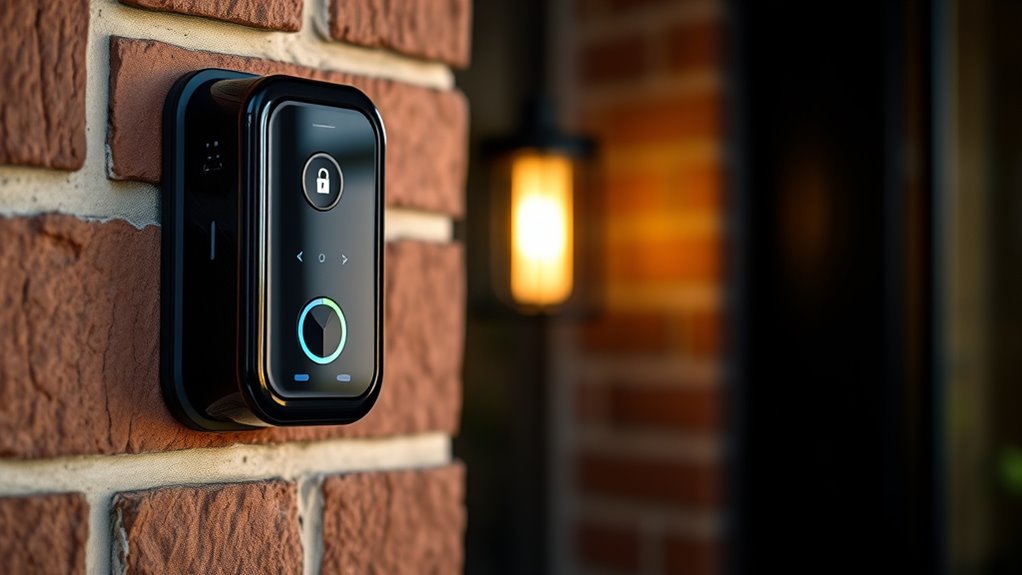
To effectively secure your smart doorbell system, you should implement strong, unique passwords for all accounts and devices. This reduces the risk of unauthorized access and protects your video feeds from tampering. When integrating your smart home system, ensure all devices are up-to-date with the latest firmware to patch vulnerabilities. Be mindful of user privacy concerns by adjusting privacy settings and limiting data sharing.
Consider these best practices:
- Enable two-factor authentication on your accounts
- Regularly update your device firmware and software
- Disable unnecessary features that may expose data
- Use a dedicated network for your smart home devices
- Review and customize privacy settings frequently
These steps help secure your system against AI manipulation and maintain control over your video feeds.
Emerging Technologies and Future Solutions

Emerging technologies are transforming the way you protect and verify smart doorbell systems, offering innovative solutions to combat deepfake threats. Advanced AI-driven detection tools now analyze video feeds in real-time, identifying manipulated content with increasing accuracy. Blockchain technology is also being explored to create secure, tamper-proof logs of footage, helping to verify authenticity and prevent unauthorized alterations. However, these innovations raise important legal implications, such as data ownership and liability issues, which must be carefully addressed. Privacy concerns also come into play, as heightened surveillance and data collection could infringe on personal privacy rights. As these technologies evolve, balancing effective security measures with respect for privacy and legal boundaries will be *vital* to ensuring trustworthy and responsible smart doorbell systems.
Tips for Homeowners to Stay Vigilant Against AI Deception

Staying vigilant against AI deception requires you to remain alert to the signs that your smart doorbell footage might be manipulated. Be cautious of unusual behaviors or inconsistencies in videos, such as unnatural movements or mismatched audio. Recognize that AI can generate hyper-realistic deepfakes, making virtual reality scenarios seem convincing. Stay aware of social engineering tactics that may be used to gain access or influence your perceptions.
Stay alert for manipulated footage, unnatural behaviors, and deepfake signs to protect against AI deception.
To stay safe, consider these tips:
- Verify footage with multiple trusted sources
- Be skeptical of sudden emotional reactions triggered by videos
- Educate yourself on common deepfake signs
- Avoid sharing sensitive info based solely on video content
- Keep firmware updated to reduce vulnerabilities
Remaining vigilant helps you spot potential AI manipulations before they cause harm.
Collaborating With Manufacturers to Improve Deepfake Resistance
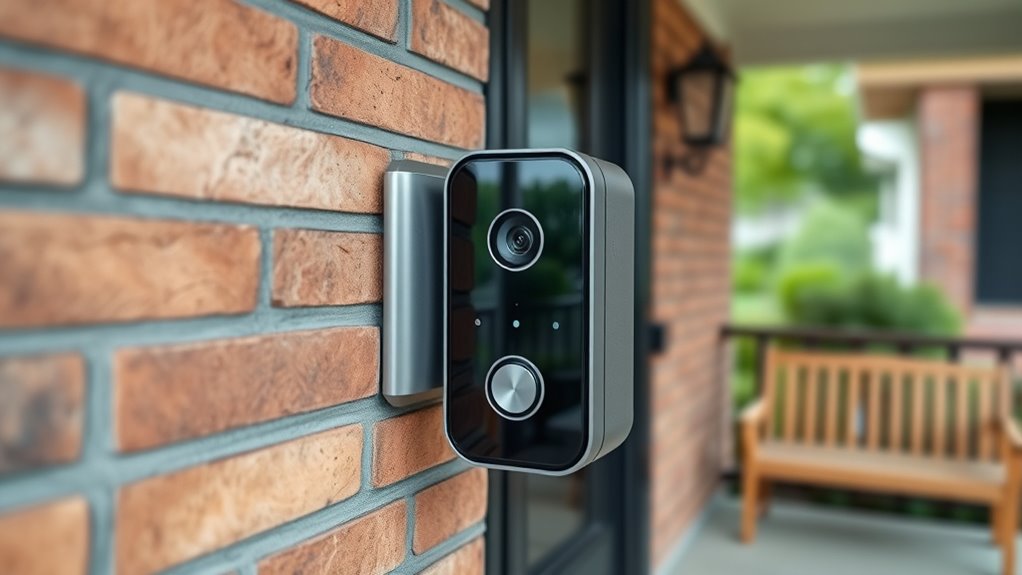
Partnering directly with manufacturers is a key step in strengthening defenses against deepfakes in smart doorbells. By establishing manufacturing partnerships, you can encourage the integration of advanced security features, such as AI-driven verification systems and real-time detection algorithms. Collaborating closely with manufacturers also allows you to influence privacy policy updates that prioritize user data protection and transparency. These updates can specify how video feeds are secured and how AI models are trained to resist manipulation. When manufacturers are proactive about implementing these measures, they create a more robust ecosystem resistant to deepfake attacks. Your involvement can ensure that privacy and security remain central, fostering trust and making deepfake exploitation considerably more challenging.
Frequently Asked Questions
Can Deepfakes Be Used to Impersonate Authorized Visitors?
Yes, deepfakes can be used to impersonate authorized visitors, posing a risk of identity theft and social engineering. You might unknowingly grant access to someone using AI-generated images or videos that mimic a trusted person. This manipulation tricks doorbell systems or security cameras, making it easier for intruders to bypass security. Stay vigilant, and consider advanced authentication methods to protect your home from these sophisticated AI threats.
How Does AI Differentiate Between Real and Manipulated Video Feeds?
You wonder how AI tells real from manipulated video feeds. It uses facial recognition to verify if faces match known profiles, and motion analysis to detect unnatural movements or inconsistencies. When these methods find discrepancies, AI flags the video as potentially manipulated. By combining facial recognition with motion analysis, AI effectively differentiates genuine footage from deepfakes, helping you stay protected from AI-driven deception.
Are There Legal Repercussions for Creating Deepfake Doorbell Videos?
You should know that creating deepfake doorbell videos can lead to legal repercussions, especially regarding legal liability and intellectual property rights. If you produce deepfakes without consent, you might face lawsuits for invasion of privacy or defamation. Additionally, using copyrighted images or footage could violate intellectual property laws. It’s vital to understand these legal boundaries to avoid serious consequences, as authorities are increasingly cracking down on malicious or unauthorized deepfake content.
What Are the Privacy Concerns Related to Deepfake Detection Technologies?
You should be aware that deepfake detection technologies raise significant privacy concerns. These systems often collect and analyze your data privacy, which could lead to unauthorized data sharing or misuse. Additionally, algorithm bias might cause unfair or inaccurate detections, impacting your trust in the technology. It is crucial to stay informed about how your data is used and advocate for transparent, unbiased algorithms to protect your privacy rights.
How Can Community Surveillance Help Combat Deepfake Doorbell Scams?
Community surveillance boosts your defenses against deepfake doorbell scams by fostering community engagement and collective oversight. When neighbors share observations and report suspicious activity, you create a network that detects and responds to AI manipulations more effectively. This collective vigilance helps identify fake videos and alerts authorities promptly, making scams less successful. Your active participation strengthens neighborhood security, making it harder for scammers to deceive residents with convincing deepfake videos.
Conclusion
As a homeowner, staying ahead of deepfake technology is essential. Did you know that over 90% of deepfake videos are used to spread misinformation? By understanding how these AI manipulations work and implementing security best practices, you can protect your video feeds from deception. Stay vigilant, regularly update your devices, and collaborate with manufacturers to enhance security. Together, we can make it harder for bad actors to exploit smart doorbells and keep your home safe.
